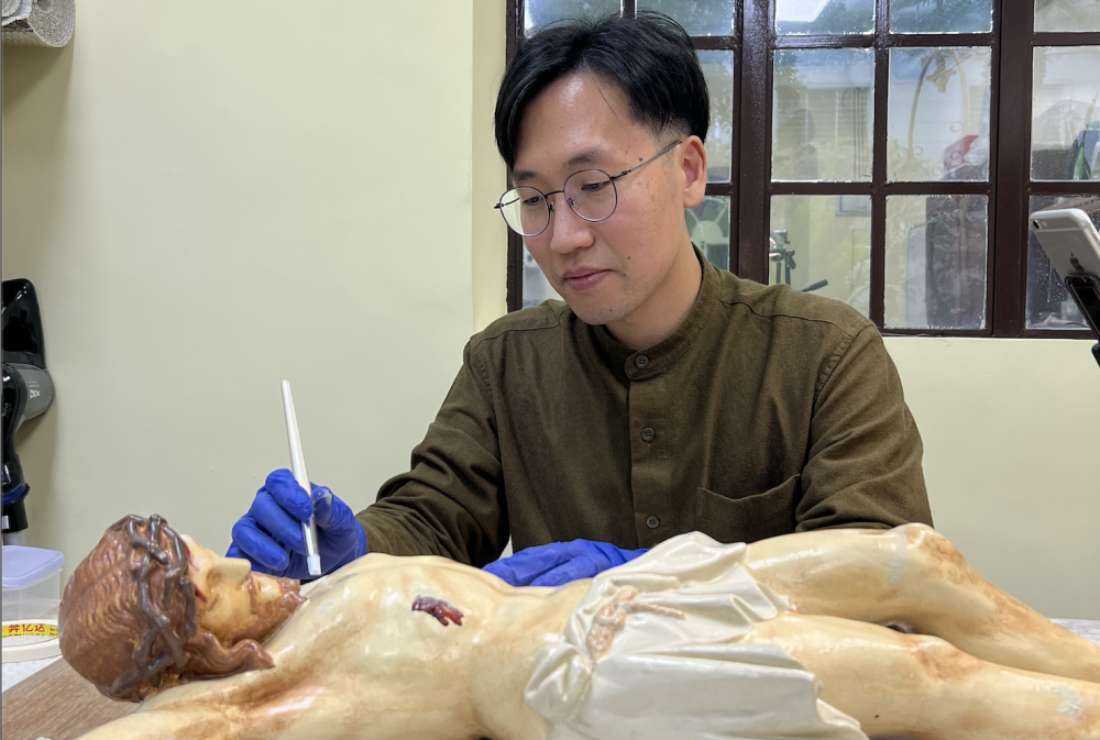
A vast collection of close to one million documents and numerous relics will be made available for public viewing

A curator polishes a historic relic at the Diocesan Archives in Macau. (Photo: Jornal-O-Clarim)
Macau diocese has officially opened its archives of close to one million documents and numerous relics with historic cultural and heritage values for public view for the first time, a Church official said.
The diocese, founded in 1576 as the first Catholic Church jurisdiction in the Far East, has preserved the documents and relics for centuries beginning during the Portuguese colonial period (1557-1999) on the island.
The Diocesan Office of Historical Archives and Patrimony located at the Bishop's House functions under the supervision of the Diocesan Chancellor and the Macau Diocesan Curia.
In 2010, UNESCO assigned some ancient books at the St. Joseph’s Seminary and archives of the Diocesan Chancery to its Memory of the World Program for the Asia-Pacific region.
Benedict Keith Ip, director of the Diocesan Archives Office, said the Church finds it important to share the history and heritage with people, Macau diocese’s Portuguese-language weekly, Jornal-O-Clarim reported on Oct. 7.
“The Church is not a museum; the Church lives in constant movement, as food for the Faith. Therefore, the meaning and witness of these cultural relics — of this tangible heritage — must be transmitted daily to the faithful in this new era,” IP said.
The principal base for the missionary work implemented in China, Japan, and other regions"
He added that the archives consist of “over a million pages of files and documents” that shed light on the rich cultural and religious history of Macau.
The documents must be at least 10 years old to be classified as a "historical archive." However, exceptions are allowed in the case of documents that relate to rare and key historical events.
Ip stated that the Diocesan Archives function as per the rules and regulations laid out by the Committee on Good Practices and Standards of the International Council of Archives.
“Our archive is divided between the Historical Records Room and the Relics Room. The first is located on the ground floor of the Episcopal Palace; the second is in the Seminary of Saint Joseph,” the official added.
Established in 1728, the Saint Joseph’s Seminary, together with St. Paul's College, was the principal base for the missionary work implemented in China, Japan, and other regions.
This church, together with the ruins of St. Paul’s College, is the only example of baroque architecture in China, as noted in UNESCO’s 2001 publication World Atlas of Baroque Architecture.
The archive is divided into three parts — common archives, historical archives, and secret archives.
Secret archives have been established as per the provisions of the Canon Law and are accessible only by the bishop who can decide on the categorization and usage of the documents.
The team conducts the cataloging and management of archives and cultural heritage, research work and promotion of cultural archives and relics, and preservation and restoration of cultural relics.
Ip stated that cultural artifacts often lose their color at the points of contact and are not damaged because of handling but because of accidents during processions.
The official also added that professional services are often required for the restoration of artifacts that are damaged due to elevated temperatures and high humidity.
“In these cases, it is necessary to call a professional to repair the relics. As for other objects, such as pillows, garments in the images, and vestments, it is necessary to find a specialized tailor,” Ip added.
"Saint Joseph’s Church holds one of Macau’s most precious religious relics"
The recent restoration done by the team was the image of Jesus.
“It took the restoration team about three months to restore the image of Jesus,” Ip said.
At present, the archivists of the Archives Office engage in the restoration of a set of oil paintings of the former prelates of the Diocese of Macau located at the Bishop's House.
Macau has a rich cultural heritage and was at the center of missionary activities in the region.
Saint Joseph’s Church holds one of Macau’s most precious religious relics, a piece of bone from the arm of St. Francis Xavier, that formerly belonged to the collection of the Church of Mater Dei (Ruins of Saint Paul’s)
St. Joseph’s Seminary taught an academic curriculum equivalent to that of a university and in 1800 Portuguese Queen Dona Maria I conferred on it the royal title of “House of the Mission Congregation”.
Beginning in the 16th century, Macau diocese covered a vast territory in Asia, from Japan to Southeast Asia. Over the centuries, more than 100 dioceses have separated from Macau diocese.
The diocese covers the entire island, which became Chinese territory after the 1999 Portuguese handover. The diocese has about 30,000 Catholics in nine parishes out of an estimated total population of 670,000.
Help us keep UCA News independent
The Church in Asia needs objective and independent journalism to speak the truth about the Church and the state.
With a network of professionally qualified journalists and editors across Asia, UCA News is just about meeting that need. But professionalism does not come cheap. We depend on you, our readers, to help maintain our independence and seek that truth.
A small donation of US$2 a month would make a big difference in our quest to achieve our goal.

Share your comments